Weeds—the pesky little invaders—often stand between avid gardeners and their dreams of a perfect, pristine lawn. From riding the breeze, floating on water, and traveling on a bird’s head (or your pet’s) to escaping from the wild, there are multiple ways they can enter your yard and never leave. Once in, they overrun the tuft, vie for resources with your precious plants, harbor harmful pests and pathogens, and even mar the aesthetic. Given the risks and damage involved, there’s no question that you would want to get rid of weeds immediately—and chemical herbicides (weed killers) are usually one such way out.
Despite being tested for safety, even the most benign herbicides can be toxic and impact the environment adversely. Leaching, surface runoff, and groundwater contamination are just some of the effects. Not to mention, they can be extremely wasteful if not applied judiciously. While using herbicides may be necessary to deal with noxious weeds, not all invasive plants require these treatments and can be dealt with through various cultural, physical, and natural methods, including pulling out, flaming, mulching, and more, as outlined below. Be cautious, though, as natural doesn’t necessarily mean it’s completely non-toxic; you may have to wear protective gear while also realizing that not all treatments will work out equally well for you depending on weed density, lawn conditions, and other environmental variables.
Yank out the unsightly growth
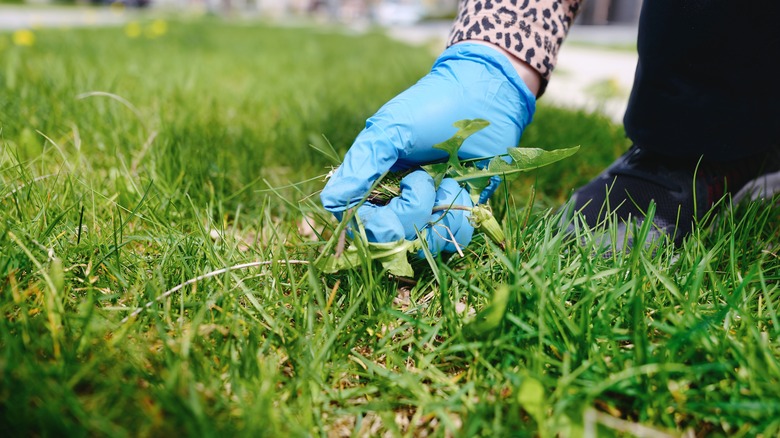
If the familiar “old is gold” adage had an equivalent, the tried and tested hand-pulling technique would be it. It’s handy, effective, and eco-friendly, albeit back-breaking and time-consuming. All you need to do is don a pair of durable gloves (leather ones if dealing with thistle and their pointy ilk) and slowly twist and pull out the invasive growth along with its roots, bulbs, and rhizomes. If the weed breaks mid-pull, use a garden fork or a trowel (hold it upright to avoid injuring your wrist) to get the rest of the plant out of the soil.
Getting all the plant material out ensures the voracious growers don’t return, especially the stubborn dandelions, bermudagrass, and spotted spurge notorious for re-rooting. To get the best results, remove the weeds from damp soil (after rain or an irrigation session; pulling weeds from dry soil is much less effective) while they’re still young. But if you’re working with compacted soil, loosen it up before weeding using a triangular-bladed hoe or a dandelion fork to pry out taproots. Granted, the toil feels satisfying and congenial in small lawns and container gardening, but it can take a toll in larger areas, so use a stool or a knee pad to make the process easier on your body.
Mulch the soil
Whether it’s bark, wood chips, dead leaves, pine needles, straw, and grass clippings, gardening mulch lends more than just aesthetic appeal to the yard; it adds nutrients while restricting weed growth. Topdressing the soil with organic mulch blocks weeds from accessing sunlight, impeding their germination. However, its effectiveness varies with the layering depth, mulch material, and weed variety. Thin layering is generally inadequate to control invasive flora, so go at least 2 to 3 inches deep when a finely-textured mulch, like composted yard waste, is involved. The downside? If the unwanted seeds find their way above the mulch layer after it rains, they’ll begin sprouting.
As nutsedges, bindweeds, and other perennial weeds can still grow out of thick organic cover, purge them with an over 4-inch-deep application of coarse mulch like bark chips and nuggets. Ensure it doesn’t retain moisture, or the weeds will start rooting when it decomposes, in addition to using up nitrogen, making it unsuitable around food plants. Refresh the mulch periodically and pull out any new seedlings as they crop up.
Spread out geotextiles or landscape fabrics
Tetiana Mykytiuk/Getty Images
Landscape fabrics are a worthy replacement if you’d rather not deal with the hassle of replenishing organic mulch, although you might still have to trim the grass and manually remove some of the bigger weeds. Mostly synthetic (yet porous), they come come in spun-bonded and woven forms. While the former are more fibrous, making them suitable for sloped lawns, the woven textiles are finer and may sometimes resemble burlap. While both deter weeds, the non-woven materials showcase better suppression, but the best type of landscape fabric for you will depend on your specific needs and soil conditions. Once laid over the garden, these fabrics are top-dressed with a 1-inch thick layer of inorganic mulch, like stones, gravel, sand, pebbles, and lava rocks, to prevent their degradation from sun exposure.
While geotextiles offer several advantages, like reusability, long life, and perennial control, they’ve their shortcomings, too. Their artificial nature deprives the soil of nutrient addition and earthworm action, unlike organic mulches. Moreover, if the airborne seeds land on the fabric, they can germinate and establish themselves, eventually piercing through the material. This makes it harder to eradicate weeds—especially yellow nutsedge—without herbicides. However, using materials like BioBarrier can minimize this issue, as it has an herbicide that solves the rooting issue. That being said, as geotextiles perform their best when placed end-to-end, they risk killing your existing foliage, too, so skip this method if you aren’t looking to replant your turf.
Suppress weeds with cover crops
Volodymyr_Shtun/Shutterstock
If you belong to the no-till club, deploy the staple farming practice of growing cover crops (green manures) in bare spots to quash the aggressive plants. Belonging to the legume or grain family, cover crops like crimson clover, oats, buckwheat, crimson clover, and rye are usually interplanted during the fall (or whenever your grasses are off-duty). They fight the invaders for resources and release allelopathic compounds (biomass) that naturally inhibit the weeds from rooting.
Accumulate 2 tons of cover biomass for every acre to eliminate 75% of weeds. However, the method remains effective even at lower biomass growth. Come winter, cover crops either die back (like oats) or turn dormant. The hibernating ones are later trimmed and mowed into the soil in spring, returning the nutrients to the ground. But if you want year-round interest, plant ground covers instead. While they stamp out weeds, their level of success will vary depending on weed density, soil conditions, cover crop variety, and other climatic variables, so take a call accordingly. For instance, if your lawn’s soil is deeply compacted, grow winter rye to loosen it with the crop’s extensive root system.
Flame your weeds
Gabor Tinz/Shutterstock
Flaming doesn’t mean you’re setting the wild growth on fire (even if you’re itching to do that). Instead, it means “blanching” them with a heavy-duty tool to ultimately kill the pesky weeds. Simply put, direct an ATV-mounted or a hand-held propane torch’s heat at the weeds and watch them wilt and wither away. The plant proteins and tissues break down in a fraction of a second when exposed to nearly 100 degrees Celsius as their moisture converts to steam, eventually destroying the weed. While this makes eradicating the intrusive plants a breeze, it does harm the adjoining growth as well, so be sure you’re prepared for it.
Avoid the practice during strong winds and dry drafts, or if your field is covered with ample flammable mulch and wood to prevent fire hazards. Flaming works best on young annual weeds, given their limited food reserves and simple root systems. In contrast, perennial weeds require multiple applications because the heat doesn’t percolate to their deeper roots. Also, don’t make the dangerous mistake of burning the poison ivy, lest it emit toxic oils. Although convenient, baking weeds is expensive, costing between $10 and $12 per acre (via UNL Extension), excluding kit costs.
Scald weeds with boiling water

Ryersonclark/Getty Images
If you’re hesitant to use the propane torch, pour hot water on the invasive weeds. Simply head to your kitchen, boil water in the kettle—preferably to over 200 degrees Fahrenheit—and bring it out to your yard in a pot holder. Decant the scorching liquid carefully on all the pest plants, ensuring it doesn’t touch your surrounding tuft. If you aren’t too sure about your skills, put on full clothing and closed shoes. Using boiling water to kill weeds works best when the pesky invaders are still young and fragile. But if the weeds are already established or have built up significant reserves—as is common with perennial weeds—repeat the process every 7 to 10 days to eradicate them.
Because the water cools down quickly once it’s off the stove, this method is suited more to small gardens. While you’ve got the option to buy professional superheated water machines, they’re fuel and water guzzlers and will burn a hole in your pocket. So, they’re best left to bigger landscapes desirous of removing the unwanted plants without herbicides. Like all contact herbicides, hot water treatment, too, can harm your surrounding lawn, making it a poor choice for spot weeding. Confining its use to lawns you plan to resod is a good call.
Suffocate with opaque covers (occultation)
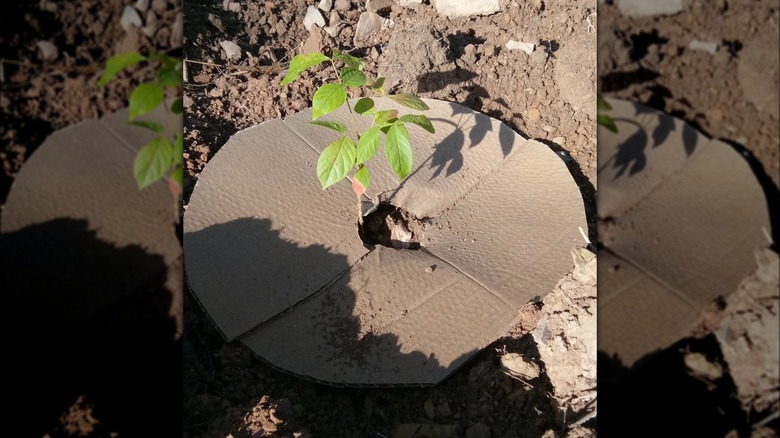
LazyMonkeyJourney/Shutterstock
Occultation refers to covering the soil with a thick, dark material, such as cardboard, black-inked newspapers, plastic sheets, or reusable tarps, to obliterate weeds. To occult, water your lawn deeply (around 12 inches of soil depth) to encourage the nuisance plants to sprout. Place the opaque cover on the problem area and secure it with heavy items like bricks, rocks, or sandbags. Use cardboard in small gardens, but swap it out for silage tarps on larger areas. Finally, top-dress the tarp with a 2-inch-thick compost or straw layer. Occultation works because the covering absorbs all light, thus depriving the weeds of sunlight and impeding their germination. However, this also means it will kill all the grasses intermixed with weeds, so be prepared to reseed the treated area.
While the process is convenient and economical (don’t we all have a spare board lying around the house?)—it has a few limitations. One, the results take time to show up—4 weeks is the minimum, but it can go up to 6 weeks or more. Perennial weeds like Japanese knotweed and Canadian thistle may even take a year to ultimately leave your property. Second, it’s mostly geared toward new seedlings, noticing substantial drops in efficacy as the weeds grow. Moreover, newspaper coverings decompose too quickly, limiting their application to quick spreaders. Cardboard disintegrates after a year but enriches the soil and attracts beneficial worms to the yard. However, avoid tilling after removing the opaque covering.
Let vinegar work its magic
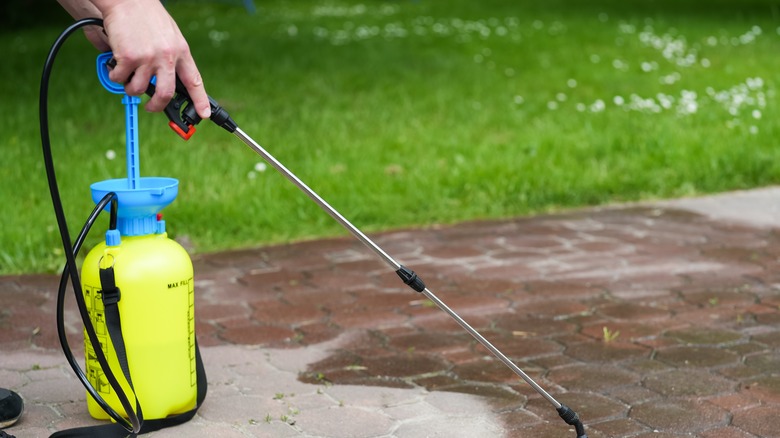
Trineso/Shutterstock
The versatile cleaning tool—vinegar—performs double duty as a contact herbicide, and it’s easy to use, too. Just transfer some to a spray bottle and spritz the liquid on the feral growth. But if you’ve got the patience, spot-treat broadleaf weeds with a brush so as not to get the vinegar onto any of your precious plants. Pick your vinegar carefully, though. While Colorado State University greenlights the use of apple cider and white (household) vinegar in your garden, highly concentrated versions like pickling vinegar or horticulture vinegar, with 9% to 20% acetic acid, are known to yield better results, as reported in a USDA experiment. Higher acetic content causes swifter destruction of the plants’ tissues and parches them dry, eventually killing them. UMD estimates that vinegar can exterminate over 90% of the nuisance plants within a day. Nevertheless, you can improve your household vinegar’s efficacy by mixing it with liquid detergent.
However, you should think twice before using vinegar to kill weeds. The timing is key, as it loses its effect on weeds aged two weeks or more. Moreover, it doesn’t permeate the root system, ultimately needing multiple applications to eliminate dandelions, horsetails, morning glory, and similar perennial weeds. Further, an overspill can contaminate the neighboring foliage and cause eye injuries and severe burns, especially if you’re using commercial vinegar. Minimize risks by spraying vinegar during the wee hours on a cloudless, windless day and maintain a two-week gap between reapplications.
Time for some soap-y love
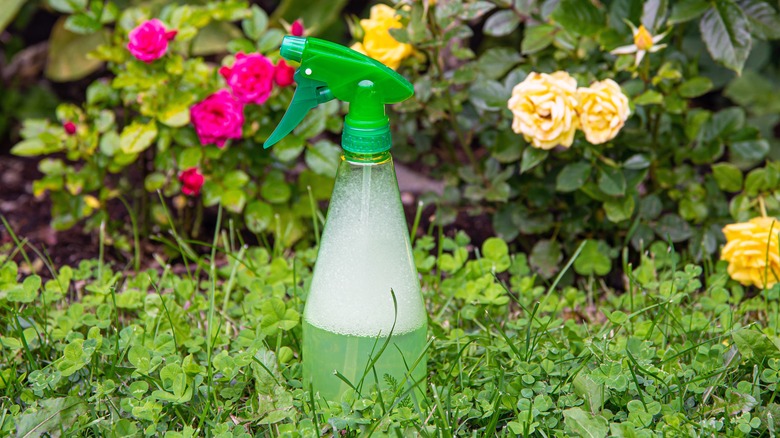
FotoHelin/Shutterstock
Somehow, Dawn dish soap has become the go-to for weed removal, even though all liquid soaps perform just as well. Regardless, you can control your weed problem with dish soap in diverse ways. The easiest recipe is to combine 4 water cups with 5 tablespoons of soap (per Colorado State University) in a spritz can and drench the unruly growth in it on a hot day of your choosing. The concoction is vicious enough to eradicate moss from your lawn within 7 days.
Another method is to add 1 tablespoon of the liquid soap to a 1-gallon vinegar solution already containing 1 cup of salt. While vinegar and salt work as an herbicide and a desiccant, respectively, UC Science interjects that the soap merely performs as a binder, meaning it helps with the coating of the solution without meaningfully enhancing the kill effect. Irrespective, the DIY weed killer does work if you follow our advice.
Another DIY formula is to combine 4 cups of distilled vinegar with 1 tablespoon of liquid detergent and ¼ cup of lemon juice. Here, lemon’s citric acid acts as the drying agent. Alternatively, you can add a pinch of salt to a hot water soapy solution to deter weeds from your yard, as recommended to House Digest by Sarah Beaumont, founder of Indoor Home Garden. While they’re all successful, results will vary based on your weed’s stubbornness (perennials!). Also, avoid spray spillover to foliage and soil.
Rinse off with vodka
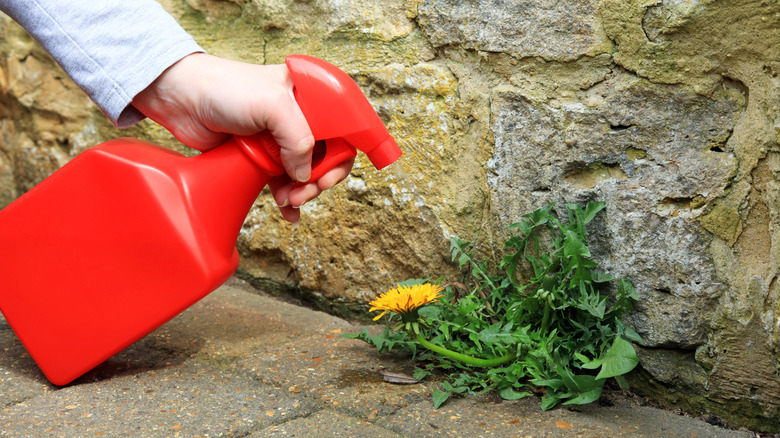
Dean Clarke/Shutterstock
You’ll be surprised to know that the spirit lying dispiritedly in your bar cabinet serves more than just an aesthetic; it’s a regular in gardening hacks that give you a green thumb, such as banishing vexatious weeds like plantains and dandelions, like a pro. Colorado State University recommends spreading an alcoholic solution of diluted vodka (one ounce of vodka in two cups of water) with two drops of soapy detergent mixed in (as a surfactant) over the unwelcome flora, especially the foliage and branches. You can switch out vodka for gin, according to Carlos Real, MD at Total Lawn (as told to Y!Sports).
As vodka is equally unsparing in dehydrating weeds, it eats away their natural protection, including the leathery coating, resulting in their untimely but essential demise. However, this weed-killing vodka hack’s success largely depends on sun exposure, as the heat augments the drying process (evaporation), so be sure to carry it out when it’s light and bright. In addition, as is common with all homemade, non-toxic pesticides, this solution, too, works non-selectively, so rather than spraying, use a brush for pointed application. That being said, err on the side of caution and don’t use the concoction to kill crabgrass, as it may injure the adjoining vegetation.
Use drip irrigation
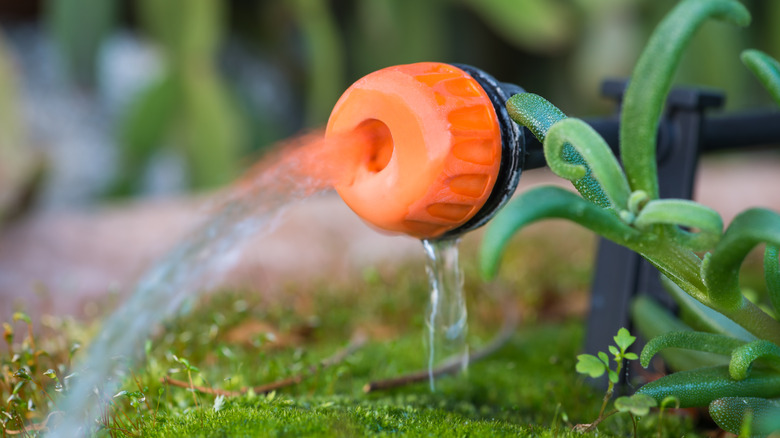
Alemasche72/Getty Images
Irrigation methods are often overlooked in the fight for weed control, and that’s a huge mistake. Depriving the pest plants of moisture by planning infrequent, deep watering schedules is one easy way to rebuff their advances. Choosing the right irrigation system is another. While sprinklers make watering bigger areas like playfields a breeze, this advantage turns into a drawback in landscapes where plants are distanced widely to give them sufficient space to grow without competing with each other. As a result, the excessive water provides a playing field for weeds that aggressively root into the ground.
Conversely, drip irrigation systems direct their water flow at specified areas of need, closer to the plant roots but not between them nor at the other unproductive soil surfaces where invasive plants can take hold. This reduces water waste, turns weeds thirsty, and ultimately stops the weeds dead in their tracks. In fact, a paper published in the Journal of Sustainable Agriculture reports the near elimination of new weeds when the area is watered using subsurface systems. Complementing the subsurface irrigation system with black synthetic (plastic) mulch can further improve weed management, as the mulch assures water retention while blocking light access for weeds. This system works especially well in hot and arid climates.
Resort to cultivation
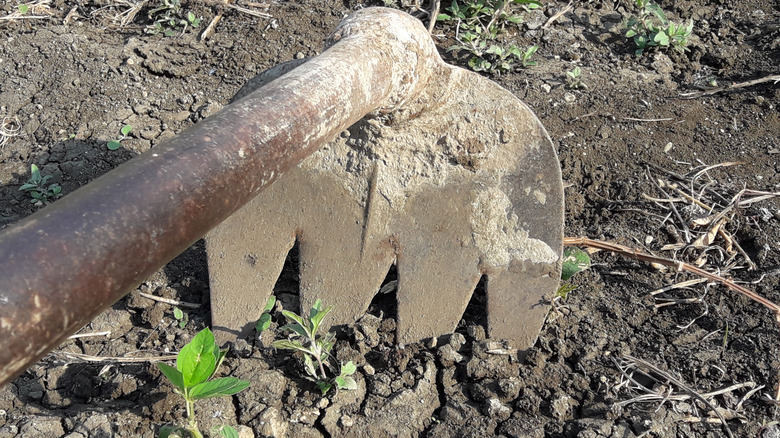
uparmar34617/Shutterstock
Cultivation, the practice of rooting out and breaking off weeds hidden underneath the top layers of soil using a hand tool or dedicated implements, is a robust way to control these obstinate plants. Essentially, it’s a worthy replacement for the hand-pulling method, which sadly doesn’t justify the time and effort required to manage the invasive growth on larger lawns. Luckily, there are several offerings on the market to meet your specific needs. For instance, manual rotary cultivators perform well along edges, including sidewalks and pavements. On the other hand, powered tillers are quicker and easier to use, especially in large landscapes.
Notwithstanding the choice, aim to minimize soil disturbance so that the deeply concealed dormant weeds remain buried and never germinate. Once the shallow weeds are taken care of, layer the soil with mulch to control future weedy growth. Cultivation works optimally in slightly damp soils on still-growing weeds—ones with no more than two leaves—and when repeated every three weeks.
Apply organic herbicides
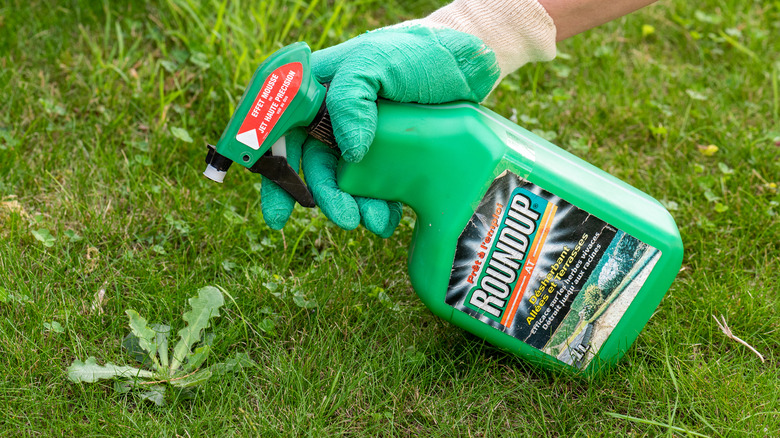
Pixavril/Shutterstock
If you’re at your wits’ end and still can’t shoo away the common garden weeds, walk down the organic herbicide aisle. They usually have plant-based concentrates or other natural elements as active ingredients that decompose easily, making them a relatively safer, pet-friendly, and environmentally sustainable option. Clove oil, lemongrass oil, citric oil (d-limonene), cinnamon oil, citric acid, acetic acid, sodium lauryl sulfate, and eugenol are some of the most common components. Apply the herbicides profusely until the product runs down the undesirable foliage for the greatest results, although a nozzle application is more suited for grasses. However, ensure the weeds aren’t taller than 4 inches or have at most 2 to 5 leaves during treatment.
While you must adhere to the label guidelines for the application rate, you can improve the process’ effectiveness by switching around the spray volumes. UMD states that higher spray volumes work far better at nixing weeds than lower volumes, even if the herbicide isn’t highly concentrated. Their impact is highest when the weather is hot (over 85 degrees Fahrenheit) and dry (low humidity), sometimes killing annual weeds within 15 minutes. However, these compounds are slow-acting on perennial weeds, merely destroying the top growth, and require successive applications. Chelated iron-containing products like Fiesta are an exception, though, as they translocate down to roots. You can also use these organic herbicides as pre-emergent treatments when spring arrives. However, these can be more expensive vis-à-vis chemical herbicides on a per-application basis.


